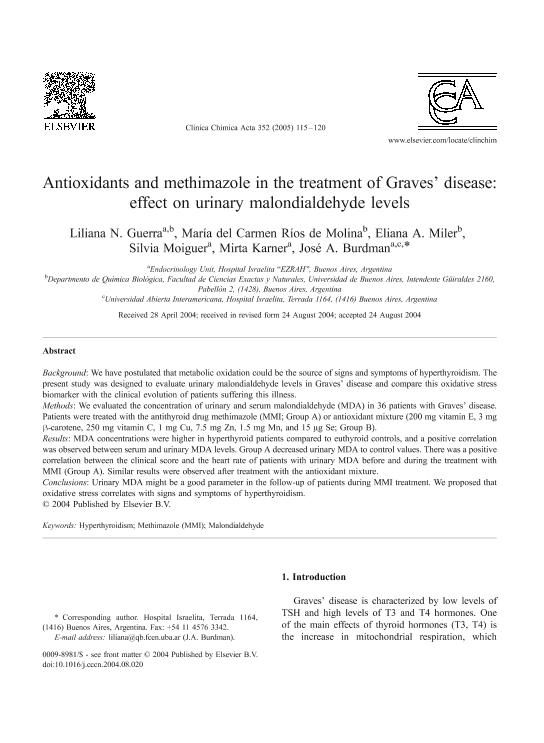Artículo
Antioxidants and methimazole in the treatment of Graves' disease: Effect on urinary malondialdehyde levels
Guerra, Liliana Noemi ; Rios, Maria del Carmen
; Rios, Maria del Carmen ; Miler, Eliana Andrea
; Miler, Eliana Andrea ; Moiguer, Silvia; Karner, Mirta; Burdman, Jose Adolfo
; Moiguer, Silvia; Karner, Mirta; Burdman, Jose Adolfo
 ; Rios, Maria del Carmen
; Rios, Maria del Carmen ; Miler, Eliana Andrea
; Miler, Eliana Andrea ; Moiguer, Silvia; Karner, Mirta; Burdman, Jose Adolfo
; Moiguer, Silvia; Karner, Mirta; Burdman, Jose Adolfo
Fecha de publicación:
02/2005
Editorial:
Elsevier Science
Revista:
Clinica Chimica Acta
ISSN:
0009-8981
Idioma:
Inglés
Tipo de recurso:
Artículo publicado
Clasificación temática:
Resumen
We have postulated that metabolic oxidation could be the source of signs and symptoms of hyperthyroidism. The present study was designed to evaluate urinary malondialdehyde levels in Graves' disease and compare this oxidative stress biomarker with the clinical evolution of patients suffering this illness. We evaluated the concentration of urinary and serum malondialdehyde (MDA) in 36 patients with Graves' disease. Patients were treated with the antithyroid drug methimazole (MMI; Group A) or antioxidant mixture (200 mg vitamin E, 3 mg β-carotene, 250 mg vitamin C, 1 mg Cu, 7.5 mg Zn, 1.5 mg Mn, and 15 μg Se; Group B). MDA concentrations were higher in hyperthyroid patients compared to euthyroid controls, and a positive correlation was observed between serum and urinary MDA levels. Group A decreased urinary MDA to control values. There was a positive correlation between the clinical score and the heart rate of patients with urinary MDA before and during the treatment with MMI (Group A). Similar results were observed after treatment with the antioxidant mixture. Urinary MDA might be a good parameter in the follow-up of patients during MMI treatment. We proposed that oxidative stress correlates with signs and symptoms of hyperthyroidism.
Palabras clave:
HYPERTHYROIDISM
,
MALONDIALDEHYDE
,
METHIMAZOLE (MMI)
Archivos asociados
Licencia
Identificadores
Colecciones
Articulos(IQUIBICEN)
Articulos de INSTITUTO DE QUIMICA BIOLOGICA DE LA FACULTAD DE CS. EXACTAS Y NATURALES
Articulos de INSTITUTO DE QUIMICA BIOLOGICA DE LA FACULTAD DE CS. EXACTAS Y NATURALES
Articulos(OCA CIUDAD UNIVERSITARIA)
Articulos de OFICINA DE COORDINACION ADMINISTRATIVA CIUDAD UNIVERSITARIA
Articulos de OFICINA DE COORDINACION ADMINISTRATIVA CIUDAD UNIVERSITARIA
Articulos(SEDE CENTRAL)
Articulos de SEDE CENTRAL
Articulos de SEDE CENTRAL
Citación
Guerra, Liliana Noemi; Rios, Maria del Carmen; Miler, Eliana Andrea; Moiguer, Silvia; Karner, Mirta; et al.; Antioxidants and methimazole in the treatment of Graves' disease: Effect on urinary malondialdehyde levels; Elsevier Science; Clinica Chimica Acta; 352; 1-2; 2-2005; 115-120
Compartir
Altmétricas



